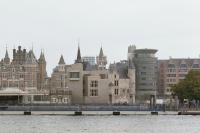Tofuku Nehando
Shibuya-ku, Tokyo, Japan
The Shibuya-yama Tofuku temple which lies at the back of the high building near urban Shibuya station in Tokyo was actually first founded around 8-900years ago in Kamakura-era.
The project was to fundamentally reconstruct the graveyard and to design corresponding new charnel house. The direct purposes were due to the several issues including circumstance beyond current system of Buddhist memorial service, location problem etc., but above all, it included the chief priest's questioning of " the Buddhism must be more open".
In particular were to ;
-Create a value of new grave in alternative to the typical stone pagodatype.
-Design an urban graveyard and charnel house where people can come by and assemble frankly.
-To have the afforestation
-Set Buddhist painting a principal image, and put back Buddhist art to the religious site.
Used prestressed concrete as a wall construction , ribbed 100mm, pitched at 650mm intervals to become the built-in wall grave. Four PC constructed walls go right through from the the roof-top to the basement. The PC walls were aimed to exist as furniture, Buddhist articles, and other tools which might be required for the temple hall, thus anchor bolts were built in every cross points of the ribs. Flat surface were placed around four walls, and required functions were given according to the varying gaps between the outer walls. I hope the grave existing space vary depending on the intended use, and be a expression of memory to the visitors.
Punching metal exterior wall
As a method of expressing "temple", I have selected titanium punching panels and placed around PC, hopefully to create a pattern like floating crowds.
The dot patterns were selectable in 5mm pitch variations, but over 50% of the surface had to be opened to tolerate wind pressure, while below 60% to pertain the strength of the panel itself, so finally had no choice other than three 20mm/25mm/30mm diameters. Four different type of dot patterns were placed in various directions, and within the certain regulations, succeeded in creating black&white shading crowds. The gathering of a shape design from the assembly of limited patterns also recalled the Japanese traditional motif-making such as "kasuri" spinning, and a figured paper "chiyogami". By arranging limited patterns, I hoped to make some sort of an expression both abstract and concrete.
- Architects
- Miurashin Architect+Associates
- Location
- Shibuya-ku, Tokyo, Japan
- Year
- 2005







